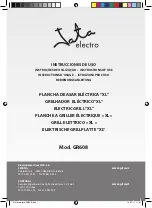
20
After the right portion of the burner is lit, light
the remaining portion of the burner.
If burner fails to ignite, contact your local
dealer for assistance.
After ignition, turn the burners to the high
position for 3-5 minutes in order to pre-heat
the barbecue. This should be done before
each cooking session. The hood or lid
should be open during preheating.
After completion of preheating, turn all
burners to the low position for best cooking
results.
9.5. Lighting the Side Burner (Omega 300)
Push and turn the side burner control knob anti-
clockwise to the high position. Push the ignitor
button rapidly until the side burner ignites. If the
side burner fails to ignite, turn the control knob
to the OFF position and wait five minutes before
attempting to re-light following the above
procedure. If the side burner still fails to ignite,
turn the control knob off, wait five minutes and
light with match.
When using the side-burner, care should be
taken to ensure that pans are central and flat on
the side-burner grid.
9.6. Grill Cooking
The burners heat up the flame tamer / lava rock
underneath the grill, which in turn heats the
food on the grill. The natural food juices
produced during cooking fall onto the hot flame
tamer / lava rock below and vaporise. The
subsequent rising smoke bastes the food, as it
travels upwards, imparting that unique
barbecued flavour.
9.7. Roasting Hood Cooking
Barbecues equipped with a roasting hood give
the option to form an ‘oven’ for roasting or
baking food, such as joints of meat or whole
chickens, etc. More even cooking of food will
actually be achieved by using the barbecue with
the hood down.
However, this should only be
done with the burners on low.
For best results, place the food you wish to
bake or roast on a metal baking tray and set it
on one side of the cooking grill.
When roasting, turn the burner to a LOW to
MEDIUM position.
Close the hood to cook the food ‘indirectly’.
Avoid lifting the hood unnecessarily as heat is
lost every time the hood is opened. If the hood
is opened during cooking please allow extra
time for the barbecue to regain its temperature
and complete the cooking. Use the temperature
gauge (if applicable) to monitor the heat of the
barbecue.
If the internal heat becomes too high, turn the
burners down to the low position. It is not
necessary or advisable to have all of the
burners on high when the hood is closed.
DO NOT ALLOW YOUR BARBECUE TO
OVERHEAT. Take care when opening the hood
as hot steam can be released on opening.
9.8. Warming Rack (where supplied)
Warming racks are a convenient way to keep
cooked food warm or to warm items such as
bread rolls. It is advisable to place food
(particularly fatty foods) to the front of the
warming rack to avoid the possibility of juices
and fat running down the back of your
barbecue. Always check that your warming rack
is properly fitted before use.
9.9. Flare-Up Control
*** Very Important Notice ***
Flare-ups occur when meat is barbecued, and
its fat and juices fall upon the hot flame tamer /
lava rock. Smoke of course helps give food its
barbecued flavour, but it is best to avoid
excessive flare-up to prevent food being
burned. To control flare-ups, it is
ABSOLUTELY ESSENTIAL
to trim away
excess fat from meat and poultry before grilling,
use cooking sauces and marinades sparingly
and try to avoid very cheap cuts of meat or
meat products as these tend to have a high fat
and water content. Also, the burners should
always be placed on the low setting during
cooking.
When flare-ups do occur, they can usually be
extinguished by applying baking soda or salt
directly onto the flame tamer / lava rock. Always
protect your hands when handling anything
near the cooking surface of the barbecue and
take care to protect yourself from the flames.
If a fat fire occurs, please see the instructions
given below.
9.10. Fat Fires
Empty and clean the grease cup of food debris
after each cooking session. If the barbecue is to
be used for large gatherings, it will be
necessary to turn off and cool the barbecue





































